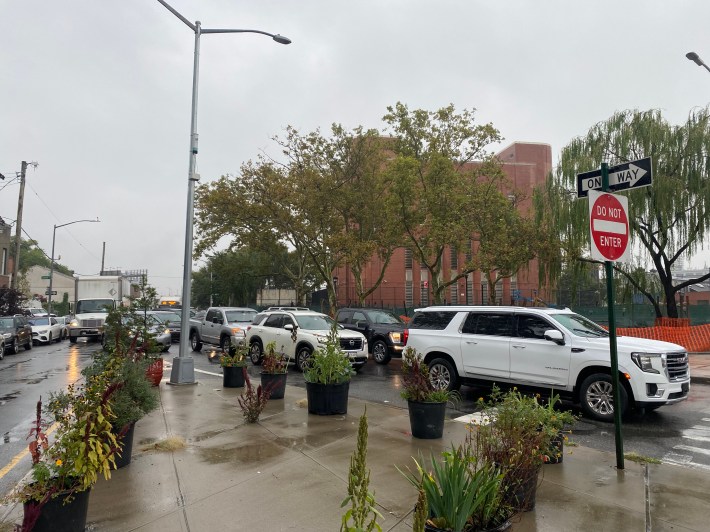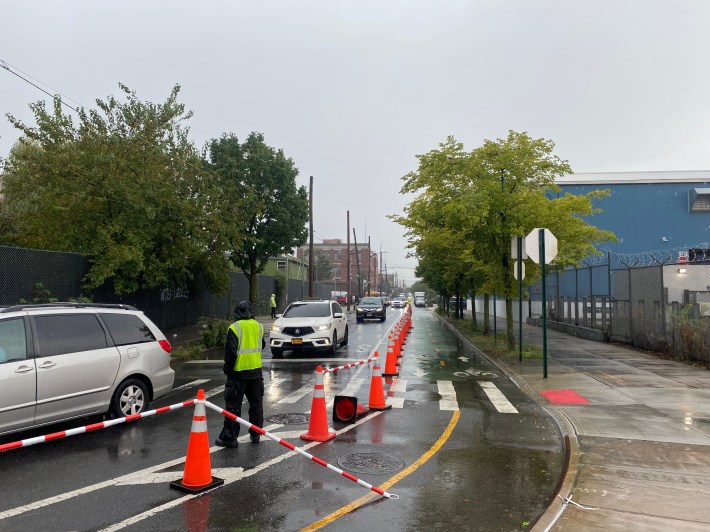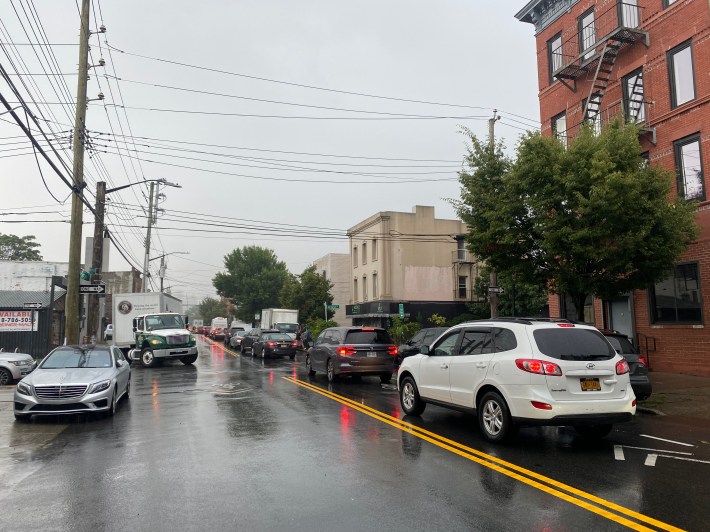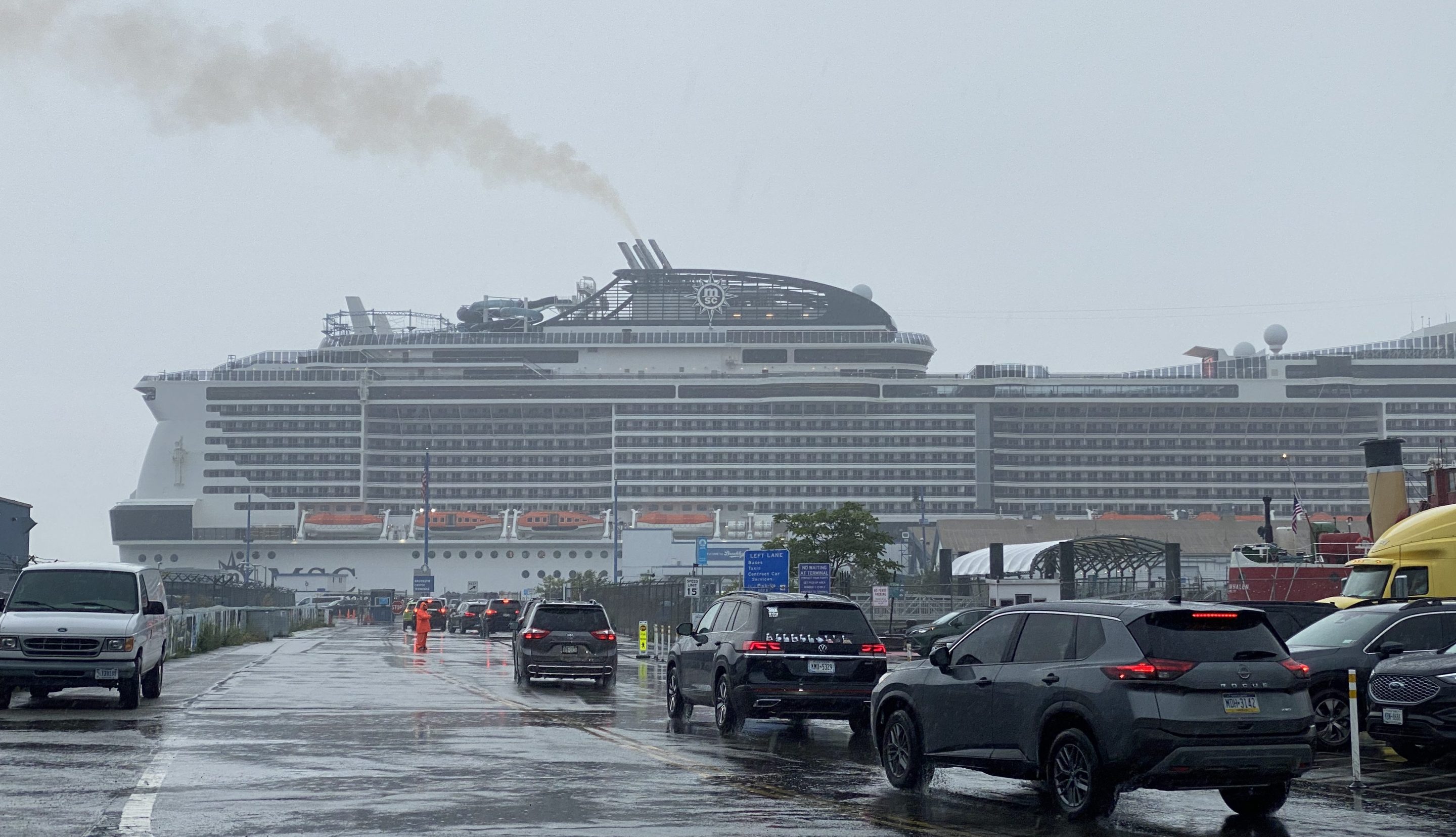Massive cruise ships that dock and unload tourists in Red Hook have wrought traffic and pollution hell on the quiet waterfront Brooklyn neighborhood, local advocates and politicians charged this week.
Hundreds of cars and dozens of trucks regularly crowd a handful of Red Hook streets to bring travelers to and from the super-sized vessels, according to city traffic counts — as the ships Mayor Adams has called a "boost to our local communities" spew noxious exhaust as fly-by-night seafarers pile into a succession of Ubers to get leave the neighborhood.
“Our residents are suffocating and the city must act,” Council Member Alexa Avilés said during a press conference outside the maritime terminal at Conover and Pioneer streets on Monday.
Cruise ships have docked at the coastal enclave for years, and pollution from the big boats is not new, but residents say the congestion during their ports of call has gotten worse this year with the arrival of larger ships.
City officials commissioned a traffic study over the summer and claim to have improved the gridlock, but Red Hook's main drag Van Brunt Street was nevertheless at a near standstill on Monday as hundreds of motorists tried to get into the shipyard to the MSC Meraviglia, one of the world’s largest cruise ships.
The "mega-ship" boasts 19 decks and is nearly as long as the Chrysler Building is tall, with capacity for 5,700 passengers, according to press materials.

The endless stream of honking cars arrives every time the large watercraft docks — usually once a week on a Sunday or Monday — shutting down vehicular access to much of the neighborhood and blocking the B61 bus, one of the few transit options available to get in or out of the subway-less nabe.
“Every time this ship comes in and embarks and disembarks, it creates a traffic nightmare here,” said Avilés. “It’s not just the cruise ship, it’s the trucks that service the cruise ship, and it’s the thousands of vehicles that we get inundated with on a daily basis.”
Mayor Adams celebrated MSC's arrival on the New York City waterfront with a highly publicized announcement last December. Hizzoner promised at the time the company would add 219,000 visitors and $102 million annually to the city economy.
"Anytime we have international travelers that come here, we just give them one assignment, spend money, spend money, spend money," Hizzoner said on Dec. 7, 2022. "This is a real boost to our economy, a boost to tourism, and a boost to contributing to our local communities, so we are thrilled MSC Cruises is dropping its anchor in New York."
Unlike other cruise ships such as the Queen Mary 2, which organizes shuttle buses, MSC drops off its travelers to make their own way into the city via individual rides — hence the high demand for Ubers and other for-hire cars, explained Carolina Salguero, who runs the nearby waterfront advocacy and education group PortSide NewYork out of an old oil tanker named the Mary Whalen docked in the shadow of the enormous cruises.
“It just obliterated this end of the neighborhood,” Salguero said. “There was nothing done to prepare for this.”
To stem the pollution, Avilés and her Council colleague Erik Bottcher, who represents the cruise terminal at Manhattan’s West Side, introduced a bill in May to require the Economic Development Corporation, which oversees the ports, to force contractors to use shore power and have a traffic mitigation plan for their time in the city.
Cruise ships emit the equivalent air pollution of more than 34,000 trucks, according to an analysis by the Coastal Conservation League, a South Carolina environmental protection organization. That would be enough trucks to cover more than half of Central Park.
The Red Hook terminal is the only cruise port on the east coast that has shore power for ships to plug into, but ships often don't use the giant electric plug, the New York Times found, because it's more expensive than just running their diesel engines, and due to power disconnecting due to wind or ship maintenance.
EDC plans to upgrade the infrastructure by the end of the year, The City reported.

The fumes add to exhaust from thousands of cars and dozens of trucks the cruise ships draw to the neighborhood every week.
Nearly 600 vehicles an hour headed into the terminal through one gate and another nearly 500 an hour headed out, according to a traffic analysis EDC presented last month. There were as many as 53 trucks an hour coming into the terminal, the traffic counters found.
Cars frequently blocked the Brooklyn Waterfront Greenway by dropping off or picking up passengers at the corner of Conover and Pioneer Streets, prompting officials to set up orange cones in recent weeks to keep the paths clear.

Way-finding apps misdirected drivers down dead ends, adding to the chaotic environment.
EDC contracted eight private traffic agents in addition to NYPD’s agents to manage tricky intersections as part of a “robust system” to address the road mayhem.
Cruise passengers have also overwhelmed the NYC Ferry system that has a stop in the terminal and is also run by EDC, and deckhands had to turn arrivals from the larger boat away.
Passengers coming off a cruise ship in Red Hook are being turned away from @NYCferry because the smaller boat can’t carry them all to Manhattan pic.twitter.com/7dkyQBMecm
— Kevin Duggan (@kduggan16) July 26, 2023
The traffic comes on top of the many last-mile warehouses for companies like Amazon and UPS that have spawned in Red Hook in recent years, prompting the city's Department of Transportation to launch a traffic study of the neighborhood in March.
EDC in an "on background" statement claimed the traffic system had "dramatically improved" since it commissioned a traffic analysis a few months ago, but the intense traffic on Monday morning called that into question.

The mayor’s alleged benefit to businesses is also questionable in the neighborhood, since there is little information in the terminal to point to points of interest in the area, prompting many to just head straight to Manhattan, according to locals.
“When you get off that ship way over there, you look like you’re in the middle of nowhere, and the Ubers and the buses they come in there and pick people up, so you never even see Red Hook,” said Carly Baker-Rice of the local merchants group the Red Hook Business Alliance. “Very few businesses see an uptick in business while the cruise ships are here.”
An EDC spokesperson defended the cruises citing their "economic impact."
"EDC is deeply committed to ensuring a sustainable and equitable future for the cruise industry in New York City which brings nearly $420 million in economic impact each year," Jeff Holmes said in a statement.






